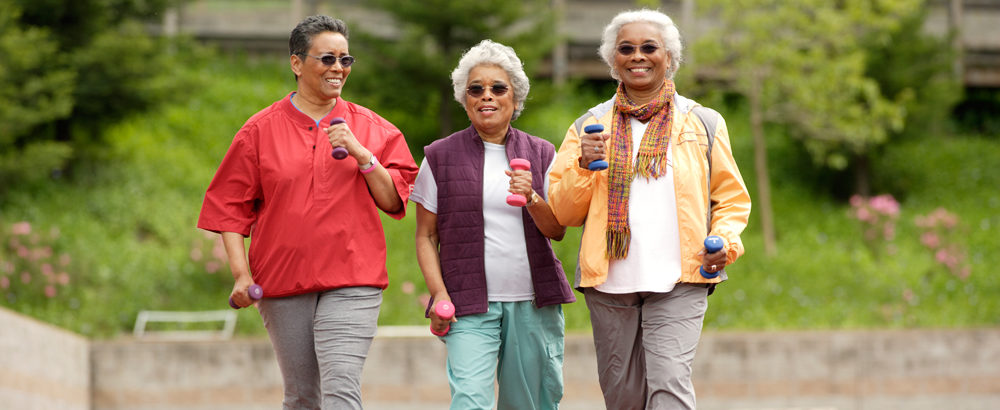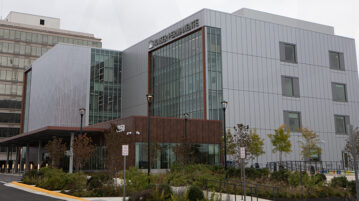By Wanda Wicks, MD
But it’s crucial not to get sidelined. Whether you are 75 or 95, regular physical activity is the best thing you can do to slow the symptoms of aging and manage the effects of chronic conditions such as diabetes, heart disease, dementia, and Parkinson’s.
And the benefits of exercise don’t stop there. Studies have shown that staying active as you age can:
- Boost your mood and sense of well-being
- Strengthen your muscles and bones (lowering the risk of falls and fractures)
- Improve your digestive health
- Increases your immune function, making it easier to fight off infection and recover from disease more quickly and easily
By getting just a bit of regular exercise each day, your muscles will grow stronger, which will help you continue doing your day-to-day activities (e.g., getting up from a chair, carrying groceries, or climbing stairs) without becoming dependent on your family and friends.
Getting Started
Engaging in moderate physical activity is safe for most older people, but if you have a heart condition, arthritis, or diabetes, it’s important to check in with your doctor before you start a new exercise regimen to talk about what’s best and safe for you. Your annual physical offers an ideal time to have this conversation and to chart out a plan for the year ahead.
If you’ve become increasingly sedentary over the years, it might seem daunting to start exercising now. But keep this in mind: It’s never too late to start in order to see improvements in your health – and even a small increase in your activity level will bring benefits.
As you are thinking about starting (or increasing) your current level of exercise, it’s helpful to aim for activities that fall within the following four general areas.
Aerobic and endurance exercise involves activities that speed up your breath and get your heart rate elevated – such as walking, cycling, or swimming. Aim for about 30 minutes each day. If time is an issue or you find yourself tiring easily, it’s fine to break the 30 minutes up into three 10-minute chunks, spread over the course of the day.
All kinds of activities count here, like playing with the grandkids, gardening or mowing the lawn, or walking to the end of your street and back. The key is to get you breathing harder and your heart beating faster. (With moderate cardio exercise, you should be able to talk, but you won’t be able to sing the words to your favorite song.) If severe weather (cold, icy winters or hot, humid summers) make it dangerous or uncomfortable to be outside, consider walking inside at your local mall.
Muscle-strengthening exercise involves activities that strengthen all of your major muscle groups: legs, hips, back, abdomen, chest, shoulders, and arms. You should shoot to do things to strengthen your muscles at least twice a week, if possible. Strength training is crucial for preventing the loss of bone mass and improving your balance.
While some seniors find it easiest to work out at the local YMCA – by training with weights, resistance bands, or nautilus machines – you can also work out at home, using walls, the floor, and furniture to provide resistance. The swimming pool also provides a safe and convenient place for resistance training; consider signing up for a class in water aerobics (which offers the added benefit of a cardio workout). Even heavy gardening will give you the strength-building workout you need, if it involves digging and shoveling.
Whatever activity you choose, aim for one or two sets of 10 to 15 repetitions for each major muscle group. As you keep with it, you’ll be able to increase the amount of weight (or level of resistance) in your workout.
Flexibility exercises help stretch your muscles and keep your body limber. By taking steps to stay more flexible, you’ll make it easier to engage in your aerobic and strength-training exercises and to keep up with your daily activities.
Try daily calf stretches, shoulder and upper arm stretches, and lower back stretches. (For illustrated instructions on suitable stretching exercises, visit the National Institute on Aging website.) Or sign up for a yoga class at your local senior center.
Balance exercises are crucial for helping you prevent falls. Many older adults enjoy boosting their balance through classes in Tai Chi, a martial art developed in China. But there are also simple exercises you can do at home, including the heel-to-toe walk or standing on one foot.
Keep It Simple and Make It Enjoyable
You’ll be more apt to stick with an exercise program that is easy to pursue and fun to do. Many older people enjoy the social boost they get from taking classes at the YMCA or local fitness center. Such centers often offer the added benefit of having certified trainers on hand who can help you exercise safely.
Pick activities you enjoy, and try to mix things up to reduce the risk of injury and avoid getting bored and giving up. Variety is the spice of life, so the golden years are a perfect time to take up an activity you’ve long had on your bucket list, such as ballroom dancing. Remember: Even small increases in activity will bring benefits, so whatever your age, take steps today to become more active.
To learn more about healthy lifestyle habits to develop as you age, visit MAPMG’s Staying Healthy pages. KPMAS also has a Thriving After 60 program with no-cost health-focused workshops and seminars, as well as social events, to help members and non-members who are 60+ stay healthy. See the box below for more information.
The KPMAS Thriving After 60 program provides a great way for members and non-members who are 60+ to attend no-cost health-focused workshops and seminars – as well as social events with a healthy twist.
These Thriving After 60 workshops and seminars will take place in many of our medical centers throughout the region and provide attendees with tips on staying active and maintaining their health. It’s also a great way to meet like-minded new friends. Click here to visit the Thriving After 60 registration site to register and sign up for updates.
Tell Your Friends and Family
We hope employees will share these opportunities with family and friends who are 60+. If you have any questions about the Thriving After 60 series, please contact Trudel Pare at trudel.s.pare@kp.org.
Please share this great program with members and non-members who may be interested in participating in upcoming Thriving After 60 events.
Do you have friends & family who are Medicare eligible? As a Kaiser Permanente member, you already know about the many benefits of our health care. Now you can share those benefits by visiting kp.org/medicare to learn more about our Medicare health plans or call 1-301-816-5651 to speak to a licensed sales specialist.





Discussion1 Comment
Exercise does help some I’m trying get back in habit of doing it and 66 I noticed that I slowed down motivation is the KEY AND STRONG WILL.